Human Resource Management: Performance, Remote Teams, and Compliance
VerifiedAdded on 2022/12/27
|20
|3761
|100
Report
AI Summary
This report delves into the core aspects of Human Resource Management (HRM), focusing on performance management models, theories, and practical applications. It begins by defining and evaluating various performance management models, such as 360-degree feedback and Key Performance Indicators (KPIs), along with their respective advantages and disadvantages. The report then explores different theories and best practices for managing performance levels, including the scientific management theory, and examines effective approaches for managing remote teams, highlighting tools like virtual reality and Zoom. The role of line managers in performance management is discussed, along with crucial legal, well-being, and health compliance considerations. Additionally, the report analyzes a case study of Google, detailing its strategies in preparing its business and staff for remote work, and assessing its approaches to performance management. The report concludes with a summary of the key findings and insights into effective HRM practices.
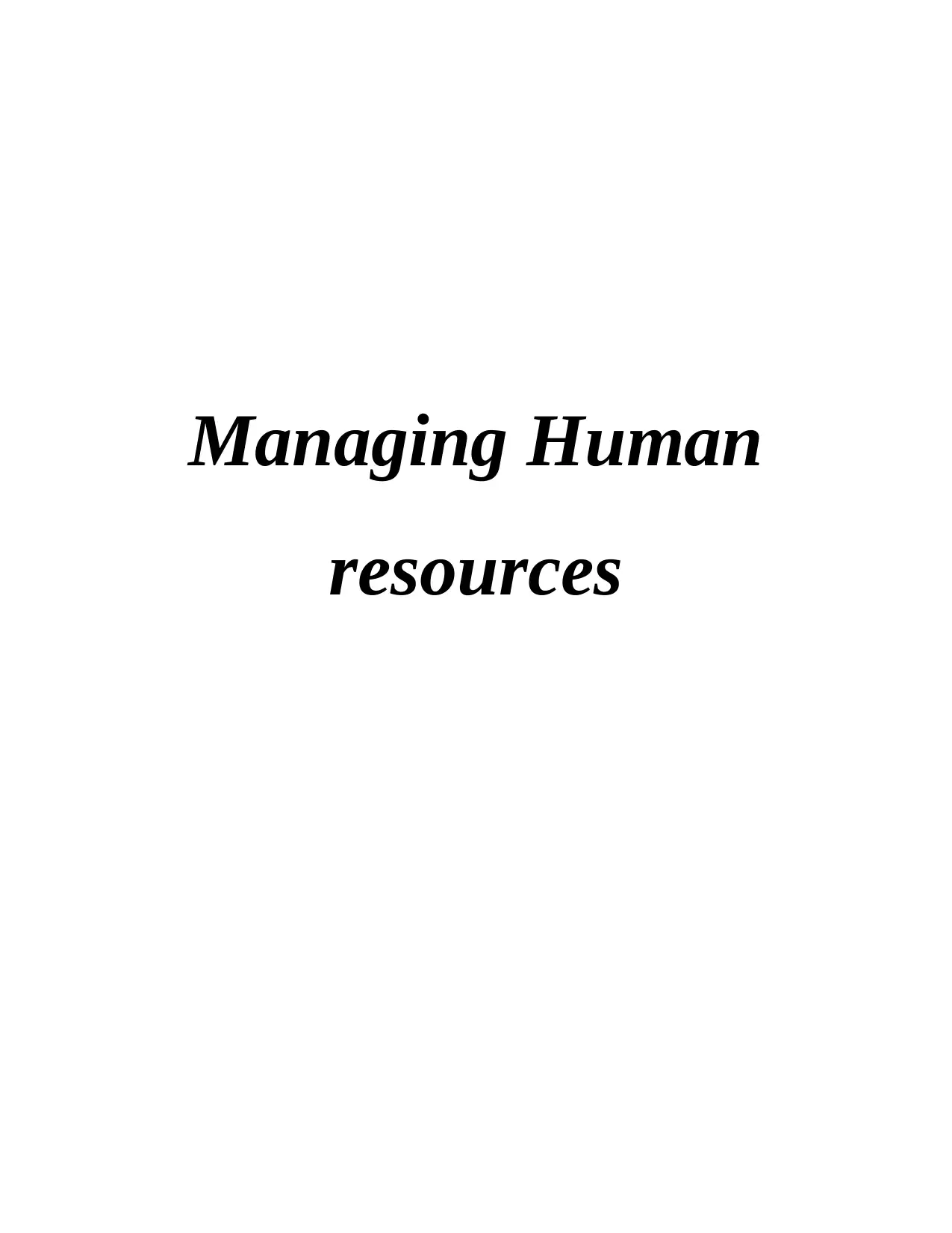
Managing Human
resources
resources
Paraphrase This Document
Need a fresh take? Get an instant paraphrase of this document with our AI Paraphraser
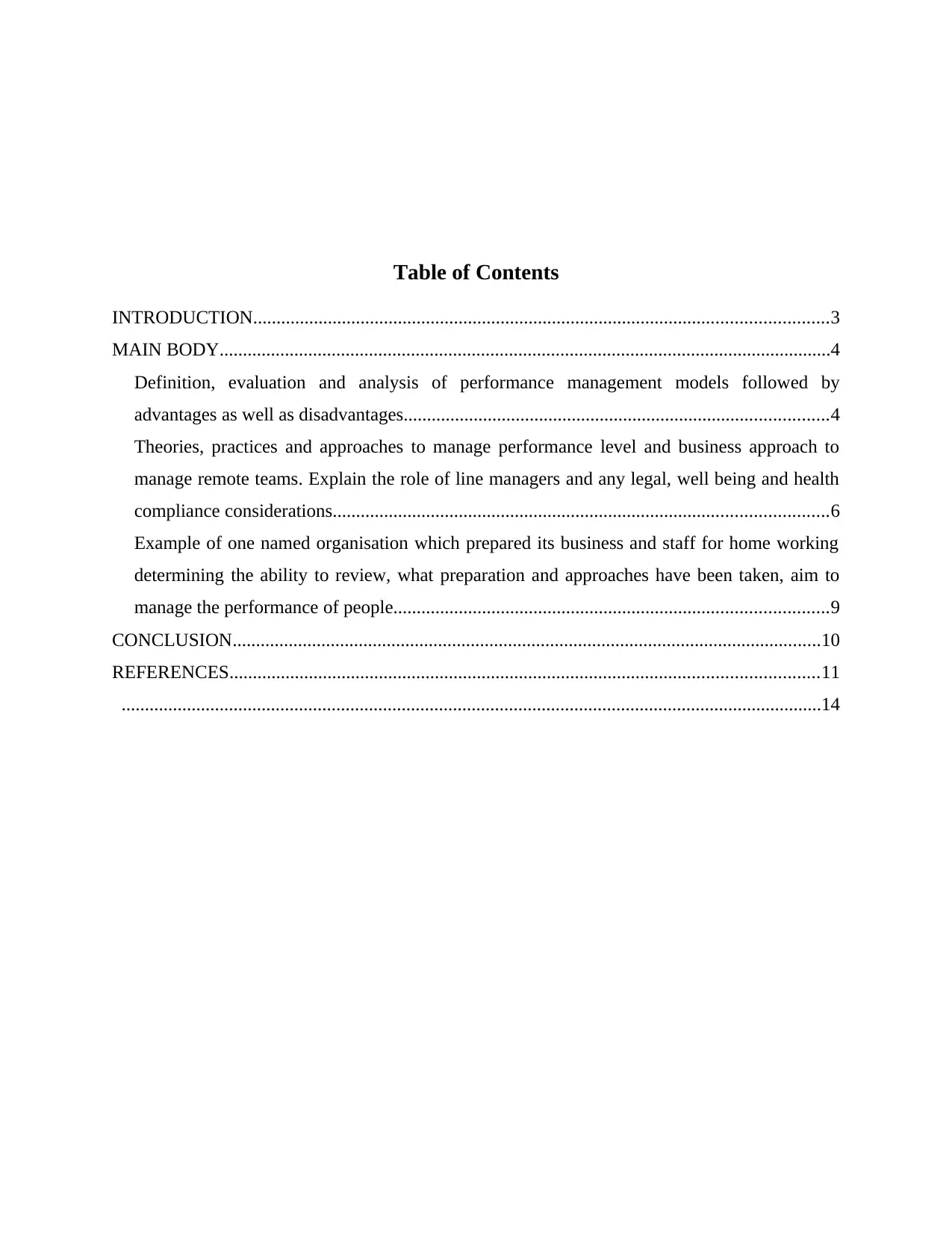
Table of Contents
INTRODUCTION...........................................................................................................................3
MAIN BODY...................................................................................................................................4
Definition, evaluation and analysis of performance management models followed by
advantages as well as disadvantages...........................................................................................4
Theories, practices and approaches to manage performance level and business approach to
manage remote teams. Explain the role of line managers and any legal, well being and health
compliance considerations..........................................................................................................6
Example of one named organisation which prepared its business and staff for home working
determining the ability to review, what preparation and approaches have been taken, aim to
manage the performance of people.............................................................................................9
CONCLUSION..............................................................................................................................10
REFERENCES..............................................................................................................................11
......................................................................................................................................................14
INTRODUCTION...........................................................................................................................3
MAIN BODY...................................................................................................................................4
Definition, evaluation and analysis of performance management models followed by
advantages as well as disadvantages...........................................................................................4
Theories, practices and approaches to manage performance level and business approach to
manage remote teams. Explain the role of line managers and any legal, well being and health
compliance considerations..........................................................................................................6
Example of one named organisation which prepared its business and staff for home working
determining the ability to review, what preparation and approaches have been taken, aim to
manage the performance of people.............................................................................................9
CONCLUSION..............................................................................................................................10
REFERENCES..............................................................................................................................11
......................................................................................................................................................14
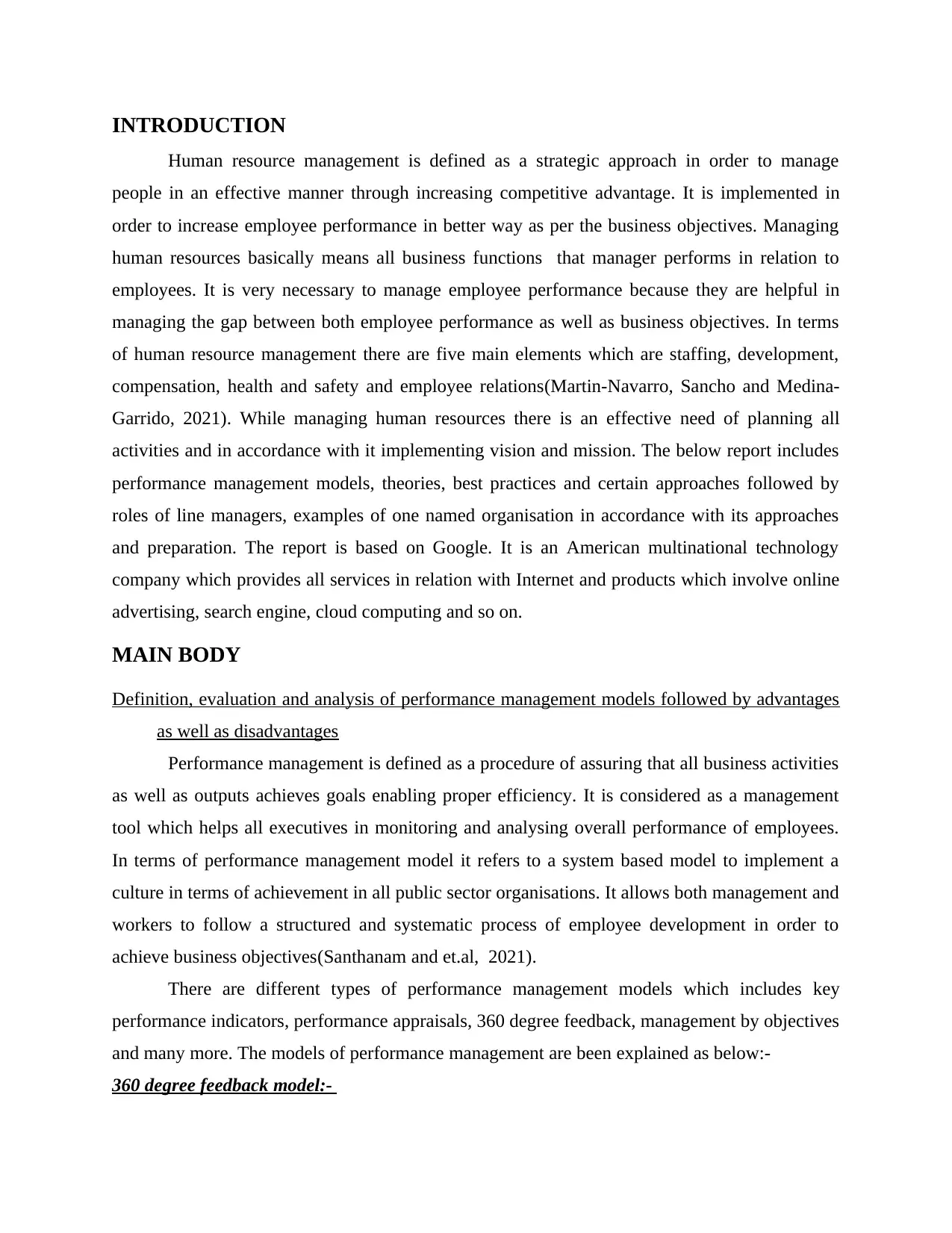
INTRODUCTION
Human resource management is defined as a strategic approach in order to manage
people in an effective manner through increasing competitive advantage. It is implemented in
order to increase employee performance in better way as per the business objectives. Managing
human resources basically means all business functions that manager performs in relation to
employees. It is very necessary to manage employee performance because they are helpful in
managing the gap between both employee performance as well as business objectives. In terms
of human resource management there are five main elements which are staffing, development,
compensation, health and safety and employee relations(Martin-Navarro, Sancho and Medina-
Garrido, 2021). While managing human resources there is an effective need of planning all
activities and in accordance with it implementing vision and mission. The below report includes
performance management models, theories, best practices and certain approaches followed by
roles of line managers, examples of one named organisation in accordance with its approaches
and preparation. The report is based on Google. It is an American multinational technology
company which provides all services in relation with Internet and products which involve online
advertising, search engine, cloud computing and so on.
MAIN BODY
Definition, evaluation and analysis of performance management models followed by advantages
as well as disadvantages
Performance management is defined as a procedure of assuring that all business activities
as well as outputs achieves goals enabling proper efficiency. It is considered as a management
tool which helps all executives in monitoring and analysing overall performance of employees.
In terms of performance management model it refers to a system based model to implement a
culture in terms of achievement in all public sector organisations. It allows both management and
workers to follow a structured and systematic process of employee development in order to
achieve business objectives(Santhanam and et.al, 2021).
There are different types of performance management models which includes key
performance indicators, performance appraisals, 360 degree feedback, management by objectives
and many more. The models of performance management are been explained as below:-
360 degree feedback model:-
Human resource management is defined as a strategic approach in order to manage
people in an effective manner through increasing competitive advantage. It is implemented in
order to increase employee performance in better way as per the business objectives. Managing
human resources basically means all business functions that manager performs in relation to
employees. It is very necessary to manage employee performance because they are helpful in
managing the gap between both employee performance as well as business objectives. In terms
of human resource management there are five main elements which are staffing, development,
compensation, health and safety and employee relations(Martin-Navarro, Sancho and Medina-
Garrido, 2021). While managing human resources there is an effective need of planning all
activities and in accordance with it implementing vision and mission. The below report includes
performance management models, theories, best practices and certain approaches followed by
roles of line managers, examples of one named organisation in accordance with its approaches
and preparation. The report is based on Google. It is an American multinational technology
company which provides all services in relation with Internet and products which involve online
advertising, search engine, cloud computing and so on.
MAIN BODY
Definition, evaluation and analysis of performance management models followed by advantages
as well as disadvantages
Performance management is defined as a procedure of assuring that all business activities
as well as outputs achieves goals enabling proper efficiency. It is considered as a management
tool which helps all executives in monitoring and analysing overall performance of employees.
In terms of performance management model it refers to a system based model to implement a
culture in terms of achievement in all public sector organisations. It allows both management and
workers to follow a structured and systematic process of employee development in order to
achieve business objectives(Santhanam and et.al, 2021).
There are different types of performance management models which includes key
performance indicators, performance appraisals, 360 degree feedback, management by objectives
and many more. The models of performance management are been explained as below:-
360 degree feedback model:-
⊘ This is a preview!⊘
Do you want full access?
Subscribe today to unlock all pages.

Trusted by 1+ million students worldwide
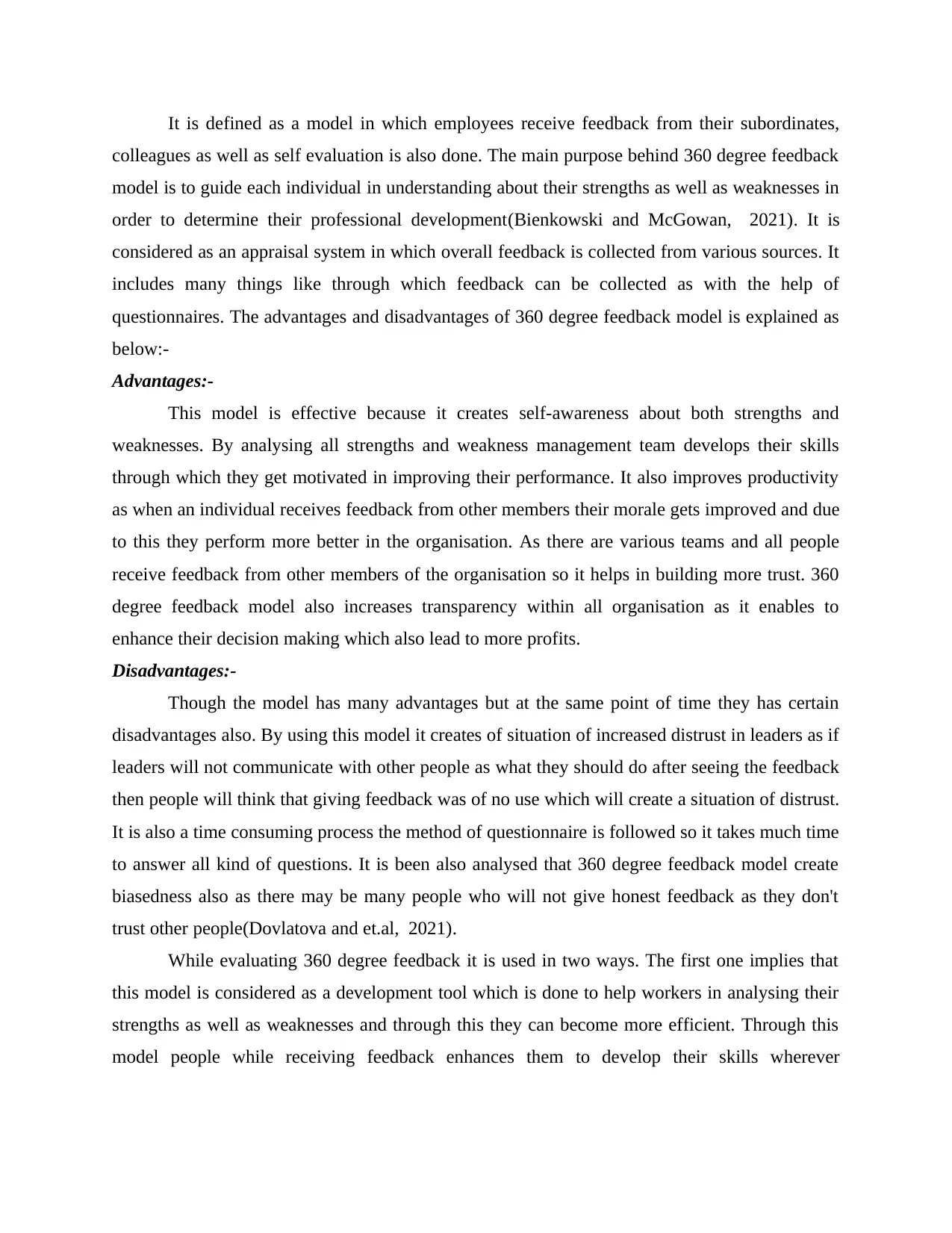
It is defined as a model in which employees receive feedback from their subordinates,
colleagues as well as self evaluation is also done. The main purpose behind 360 degree feedback
model is to guide each individual in understanding about their strengths as well as weaknesses in
order to determine their professional development(Bienkowski and McGowan, 2021). It is
considered as an appraisal system in which overall feedback is collected from various sources. It
includes many things like through which feedback can be collected as with the help of
questionnaires. The advantages and disadvantages of 360 degree feedback model is explained as
below:-
Advantages:-
This model is effective because it creates self-awareness about both strengths and
weaknesses. By analysing all strengths and weakness management team develops their skills
through which they get motivated in improving their performance. It also improves productivity
as when an individual receives feedback from other members their morale gets improved and due
to this they perform more better in the organisation. As there are various teams and all people
receive feedback from other members of the organisation so it helps in building more trust. 360
degree feedback model also increases transparency within all organisation as it enables to
enhance their decision making which also lead to more profits.
Disadvantages:-
Though the model has many advantages but at the same point of time they has certain
disadvantages also. By using this model it creates of situation of increased distrust in leaders as if
leaders will not communicate with other people as what they should do after seeing the feedback
then people will think that giving feedback was of no use which will create a situation of distrust.
It is also a time consuming process the method of questionnaire is followed so it takes much time
to answer all kind of questions. It is been also analysed that 360 degree feedback model create
biasedness also as there may be many people who will not give honest feedback as they don't
trust other people(Dovlatova and et.al, 2021).
While evaluating 360 degree feedback it is used in two ways. The first one implies that
this model is considered as a development tool which is done to help workers in analysing their
strengths as well as weaknesses and through this they can become more efficient. Through this
model people while receiving feedback enhances them to develop their skills wherever
colleagues as well as self evaluation is also done. The main purpose behind 360 degree feedback
model is to guide each individual in understanding about their strengths as well as weaknesses in
order to determine their professional development(Bienkowski and McGowan, 2021). It is
considered as an appraisal system in which overall feedback is collected from various sources. It
includes many things like through which feedback can be collected as with the help of
questionnaires. The advantages and disadvantages of 360 degree feedback model is explained as
below:-
Advantages:-
This model is effective because it creates self-awareness about both strengths and
weaknesses. By analysing all strengths and weakness management team develops their skills
through which they get motivated in improving their performance. It also improves productivity
as when an individual receives feedback from other members their morale gets improved and due
to this they perform more better in the organisation. As there are various teams and all people
receive feedback from other members of the organisation so it helps in building more trust. 360
degree feedback model also increases transparency within all organisation as it enables to
enhance their decision making which also lead to more profits.
Disadvantages:-
Though the model has many advantages but at the same point of time they has certain
disadvantages also. By using this model it creates of situation of increased distrust in leaders as if
leaders will not communicate with other people as what they should do after seeing the feedback
then people will think that giving feedback was of no use which will create a situation of distrust.
It is also a time consuming process the method of questionnaire is followed so it takes much time
to answer all kind of questions. It is been also analysed that 360 degree feedback model create
biasedness also as there may be many people who will not give honest feedback as they don't
trust other people(Dovlatova and et.al, 2021).
While evaluating 360 degree feedback it is used in two ways. The first one implies that
this model is considered as a development tool which is done to help workers in analysing their
strengths as well as weaknesses and through this they can become more efficient. Through this
model people while receiving feedback enhances them to develop their skills wherever
Paraphrase This Document
Need a fresh take? Get an instant paraphrase of this document with our AI Paraphraser
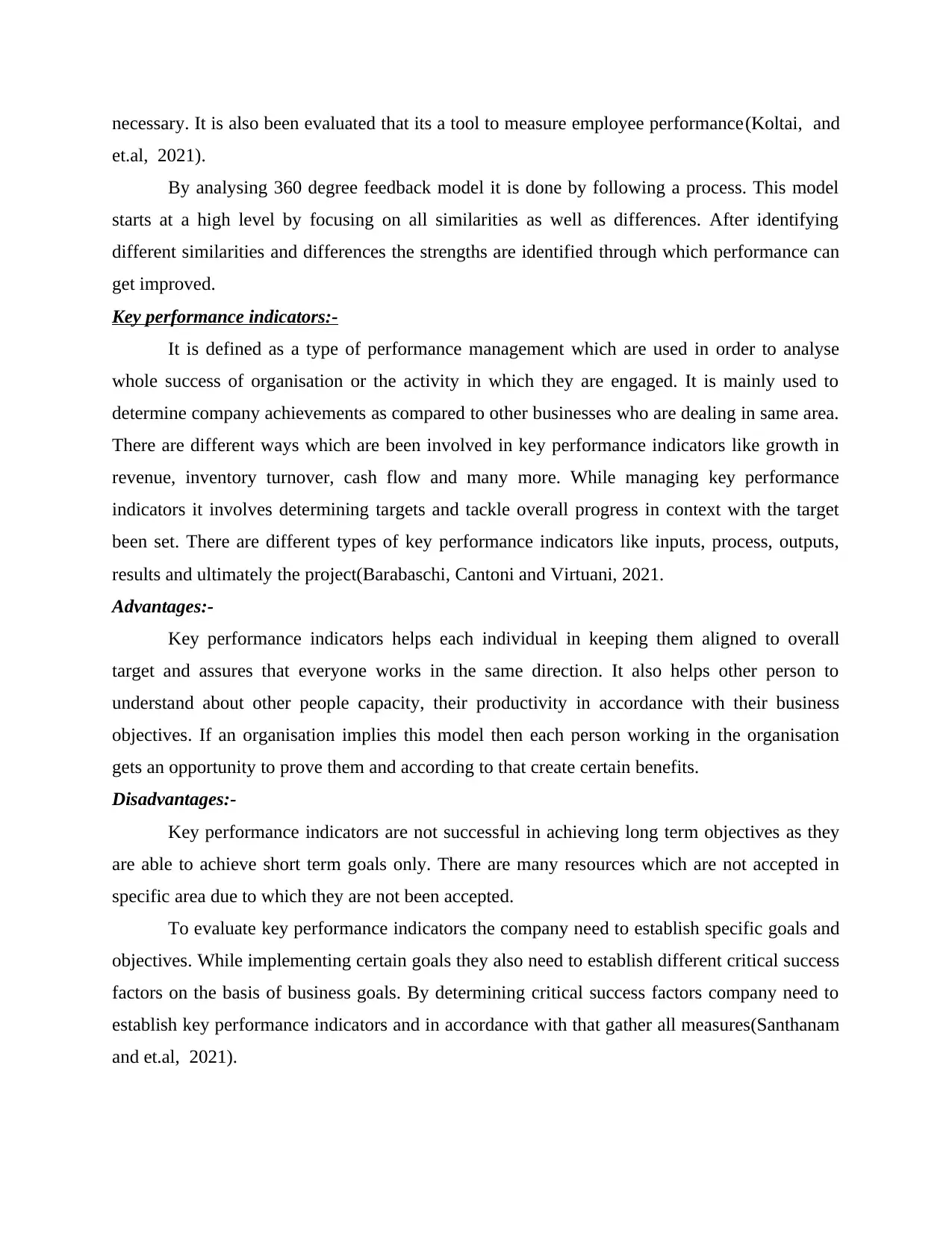
necessary. It is also been evaluated that its a tool to measure employee performance(Koltai, and
et.al, 2021).
By analysing 360 degree feedback model it is done by following a process. This model
starts at a high level by focusing on all similarities as well as differences. After identifying
different similarities and differences the strengths are identified through which performance can
get improved.
Key performance indicators:-
It is defined as a type of performance management which are used in order to analyse
whole success of organisation or the activity in which they are engaged. It is mainly used to
determine company achievements as compared to other businesses who are dealing in same area.
There are different ways which are been involved in key performance indicators like growth in
revenue, inventory turnover, cash flow and many more. While managing key performance
indicators it involves determining targets and tackle overall progress in context with the target
been set. There are different types of key performance indicators like inputs, process, outputs,
results and ultimately the project(Barabaschi, Cantoni and Virtuani, 2021.
Advantages:-
Key performance indicators helps each individual in keeping them aligned to overall
target and assures that everyone works in the same direction. It also helps other person to
understand about other people capacity, their productivity in accordance with their business
objectives. If an organisation implies this model then each person working in the organisation
gets an opportunity to prove them and according to that create certain benefits.
Disadvantages:-
Key performance indicators are not successful in achieving long term objectives as they
are able to achieve short term goals only. There are many resources which are not accepted in
specific area due to which they are not been accepted.
To evaluate key performance indicators the company need to establish specific goals and
objectives. While implementing certain goals they also need to establish different critical success
factors on the basis of business goals. By determining critical success factors company need to
establish key performance indicators and in accordance with that gather all measures(Santhanam
and et.al, 2021).
et.al, 2021).
By analysing 360 degree feedback model it is done by following a process. This model
starts at a high level by focusing on all similarities as well as differences. After identifying
different similarities and differences the strengths are identified through which performance can
get improved.
Key performance indicators:-
It is defined as a type of performance management which are used in order to analyse
whole success of organisation or the activity in which they are engaged. It is mainly used to
determine company achievements as compared to other businesses who are dealing in same area.
There are different ways which are been involved in key performance indicators like growth in
revenue, inventory turnover, cash flow and many more. While managing key performance
indicators it involves determining targets and tackle overall progress in context with the target
been set. There are different types of key performance indicators like inputs, process, outputs,
results and ultimately the project(Barabaschi, Cantoni and Virtuani, 2021.
Advantages:-
Key performance indicators helps each individual in keeping them aligned to overall
target and assures that everyone works in the same direction. It also helps other person to
understand about other people capacity, their productivity in accordance with their business
objectives. If an organisation implies this model then each person working in the organisation
gets an opportunity to prove them and according to that create certain benefits.
Disadvantages:-
Key performance indicators are not successful in achieving long term objectives as they
are able to achieve short term goals only. There are many resources which are not accepted in
specific area due to which they are not been accepted.
To evaluate key performance indicators the company need to establish specific goals and
objectives. While implementing certain goals they also need to establish different critical success
factors on the basis of business goals. By determining critical success factors company need to
establish key performance indicators and in accordance with that gather all measures(Santhanam
and et.al, 2021).
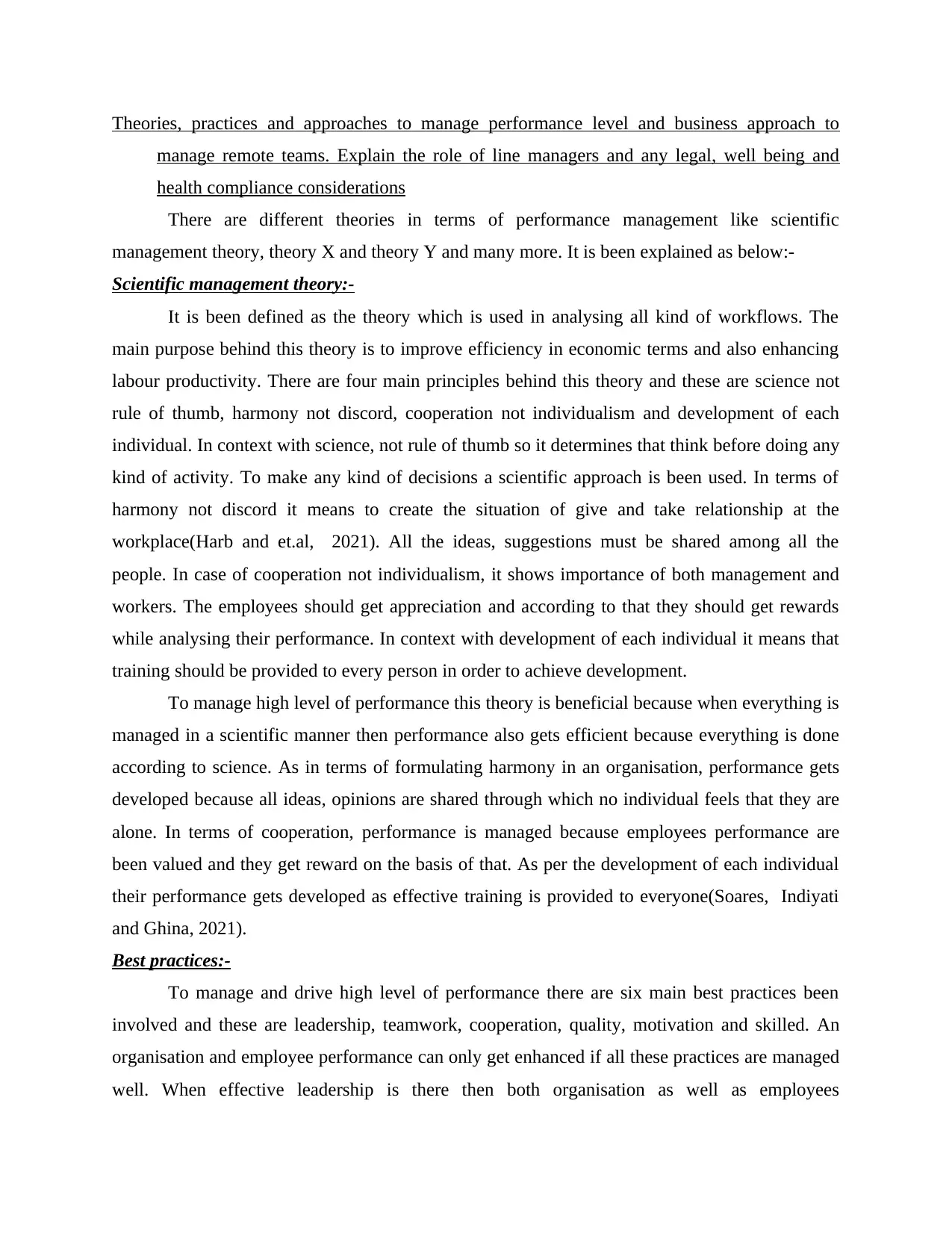
Theories, practices and approaches to manage performance level and business approach to
manage remote teams. Explain the role of line managers and any legal, well being and
health compliance considerations
There are different theories in terms of performance management like scientific
management theory, theory X and theory Y and many more. It is been explained as below:-
Scientific management theory:-
It is been defined as the theory which is used in analysing all kind of workflows. The
main purpose behind this theory is to improve efficiency in economic terms and also enhancing
labour productivity. There are four main principles behind this theory and these are science not
rule of thumb, harmony not discord, cooperation not individualism and development of each
individual. In context with science, not rule of thumb so it determines that think before doing any
kind of activity. To make any kind of decisions a scientific approach is been used. In terms of
harmony not discord it means to create the situation of give and take relationship at the
workplace(Harb and et.al, 2021). All the ideas, suggestions must be shared among all the
people. In case of cooperation not individualism, it shows importance of both management and
workers. The employees should get appreciation and according to that they should get rewards
while analysing their performance. In context with development of each individual it means that
training should be provided to every person in order to achieve development.
To manage high level of performance this theory is beneficial because when everything is
managed in a scientific manner then performance also gets efficient because everything is done
according to science. As in terms of formulating harmony in an organisation, performance gets
developed because all ideas, opinions are shared through which no individual feels that they are
alone. In terms of cooperation, performance is managed because employees performance are
been valued and they get reward on the basis of that. As per the development of each individual
their performance gets developed as effective training is provided to everyone(Soares, Indiyati
and Ghina, 2021).
Best practices:-
To manage and drive high level of performance there are six main best practices been
involved and these are leadership, teamwork, cooperation, quality, motivation and skilled. An
organisation and employee performance can only get enhanced if all these practices are managed
well. When effective leadership is there then both organisation as well as employees
manage remote teams. Explain the role of line managers and any legal, well being and
health compliance considerations
There are different theories in terms of performance management like scientific
management theory, theory X and theory Y and many more. It is been explained as below:-
Scientific management theory:-
It is been defined as the theory which is used in analysing all kind of workflows. The
main purpose behind this theory is to improve efficiency in economic terms and also enhancing
labour productivity. There are four main principles behind this theory and these are science not
rule of thumb, harmony not discord, cooperation not individualism and development of each
individual. In context with science, not rule of thumb so it determines that think before doing any
kind of activity. To make any kind of decisions a scientific approach is been used. In terms of
harmony not discord it means to create the situation of give and take relationship at the
workplace(Harb and et.al, 2021). All the ideas, suggestions must be shared among all the
people. In case of cooperation not individualism, it shows importance of both management and
workers. The employees should get appreciation and according to that they should get rewards
while analysing their performance. In context with development of each individual it means that
training should be provided to every person in order to achieve development.
To manage high level of performance this theory is beneficial because when everything is
managed in a scientific manner then performance also gets efficient because everything is done
according to science. As in terms of formulating harmony in an organisation, performance gets
developed because all ideas, opinions are shared through which no individual feels that they are
alone. In terms of cooperation, performance is managed because employees performance are
been valued and they get reward on the basis of that. As per the development of each individual
their performance gets developed as effective training is provided to everyone(Soares, Indiyati
and Ghina, 2021).
Best practices:-
To manage and drive high level of performance there are six main best practices been
involved and these are leadership, teamwork, cooperation, quality, motivation and skilled. An
organisation and employee performance can only get enhanced if all these practices are managed
well. When effective leadership is there then both organisation as well as employees
⊘ This is a preview!⊘
Do you want full access?
Subscribe today to unlock all pages.

Trusted by 1+ million students worldwide
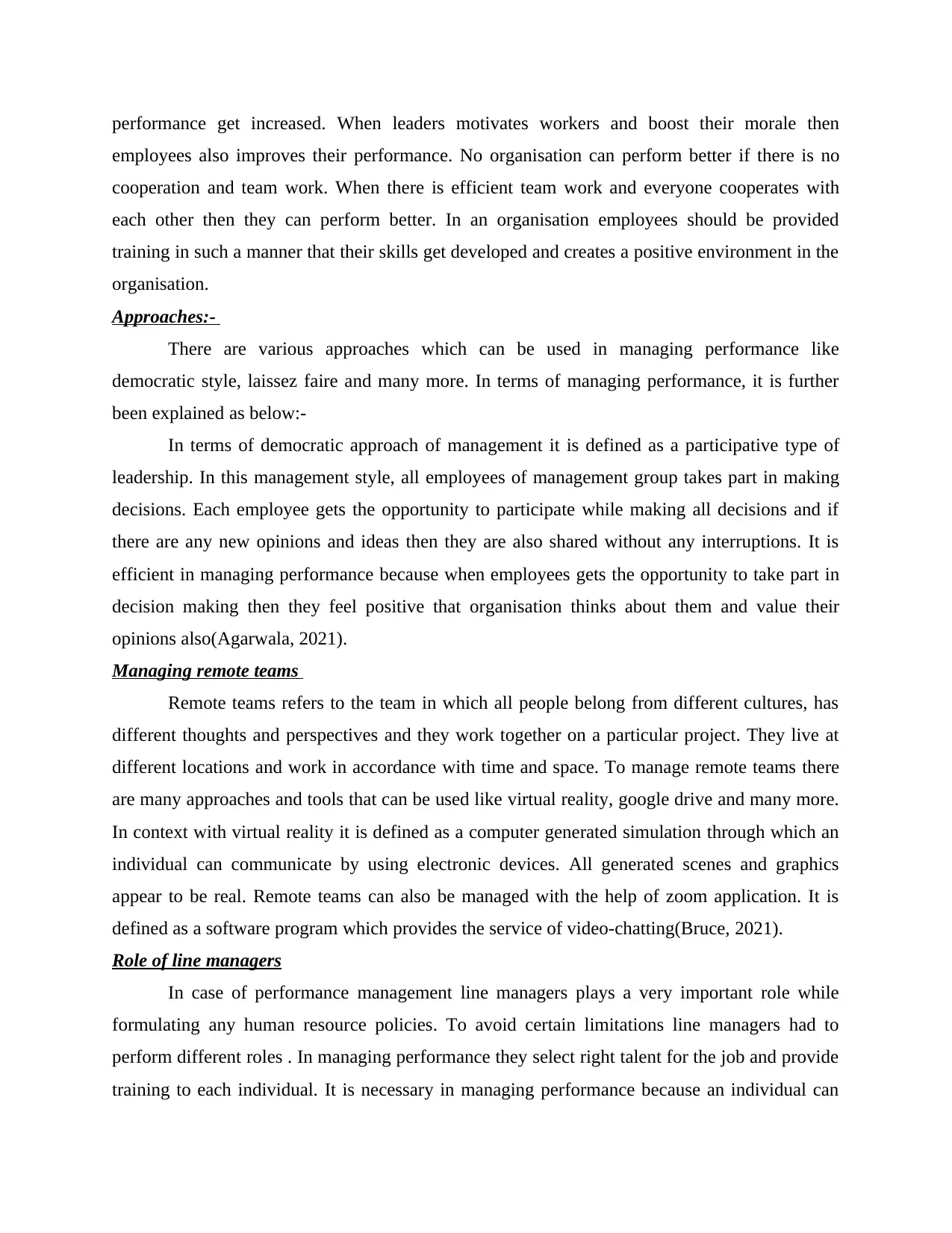
performance get increased. When leaders motivates workers and boost their morale then
employees also improves their performance. No organisation can perform better if there is no
cooperation and team work. When there is efficient team work and everyone cooperates with
each other then they can perform better. In an organisation employees should be provided
training in such a manner that their skills get developed and creates a positive environment in the
organisation.
Approaches:-
There are various approaches which can be used in managing performance like
democratic style, laissez faire and many more. In terms of managing performance, it is further
been explained as below:-
In terms of democratic approach of management it is defined as a participative type of
leadership. In this management style, all employees of management group takes part in making
decisions. Each employee gets the opportunity to participate while making all decisions and if
there are any new opinions and ideas then they are also shared without any interruptions. It is
efficient in managing performance because when employees gets the opportunity to take part in
decision making then they feel positive that organisation thinks about them and value their
opinions also(Agarwala, 2021).
Managing remote teams
Remote teams refers to the team in which all people belong from different cultures, has
different thoughts and perspectives and they work together on a particular project. They live at
different locations and work in accordance with time and space. To manage remote teams there
are many approaches and tools that can be used like virtual reality, google drive and many more.
In context with virtual reality it is defined as a computer generated simulation through which an
individual can communicate by using electronic devices. All generated scenes and graphics
appear to be real. Remote teams can also be managed with the help of zoom application. It is
defined as a software program which provides the service of video-chatting(Bruce, 2021).
Role of line managers
In case of performance management line managers plays a very important role while
formulating any human resource policies. To avoid certain limitations line managers had to
perform different roles . In managing performance they select right talent for the job and provide
training to each individual. It is necessary in managing performance because an individual can
employees also improves their performance. No organisation can perform better if there is no
cooperation and team work. When there is efficient team work and everyone cooperates with
each other then they can perform better. In an organisation employees should be provided
training in such a manner that their skills get developed and creates a positive environment in the
organisation.
Approaches:-
There are various approaches which can be used in managing performance like
democratic style, laissez faire and many more. In terms of managing performance, it is further
been explained as below:-
In terms of democratic approach of management it is defined as a participative type of
leadership. In this management style, all employees of management group takes part in making
decisions. Each employee gets the opportunity to participate while making all decisions and if
there are any new opinions and ideas then they are also shared without any interruptions. It is
efficient in managing performance because when employees gets the opportunity to take part in
decision making then they feel positive that organisation thinks about them and value their
opinions also(Agarwala, 2021).
Managing remote teams
Remote teams refers to the team in which all people belong from different cultures, has
different thoughts and perspectives and they work together on a particular project. They live at
different locations and work in accordance with time and space. To manage remote teams there
are many approaches and tools that can be used like virtual reality, google drive and many more.
In context with virtual reality it is defined as a computer generated simulation through which an
individual can communicate by using electronic devices. All generated scenes and graphics
appear to be real. Remote teams can also be managed with the help of zoom application. It is
defined as a software program which provides the service of video-chatting(Bruce, 2021).
Role of line managers
In case of performance management line managers plays a very important role while
formulating any human resource policies. To avoid certain limitations line managers had to
perform different roles . In managing performance they select right talent for the job and provide
training to each individual. It is necessary in managing performance because an individual can
Paraphrase This Document
Need a fresh take? Get an instant paraphrase of this document with our AI Paraphraser
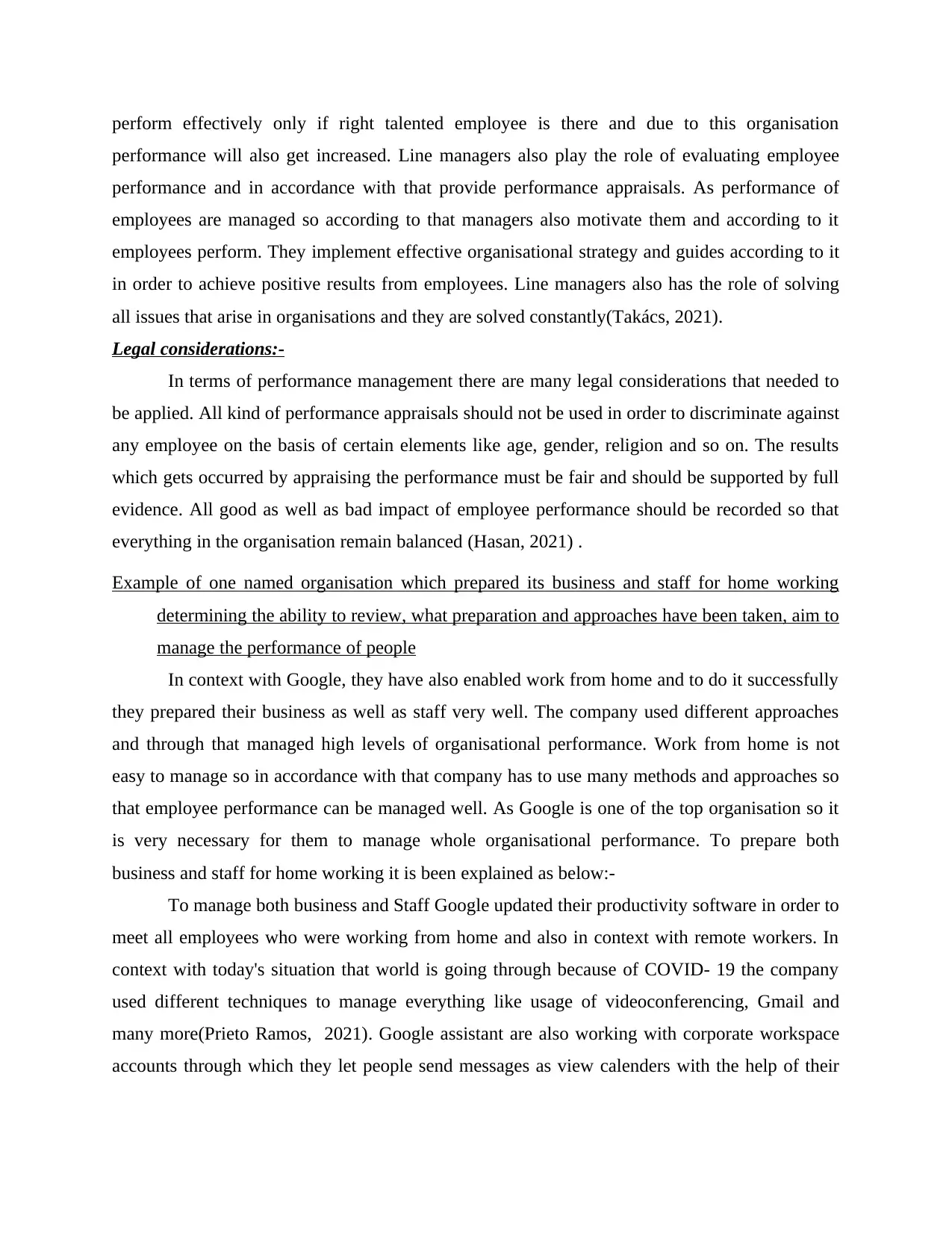
perform effectively only if right talented employee is there and due to this organisation
performance will also get increased. Line managers also play the role of evaluating employee
performance and in accordance with that provide performance appraisals. As performance of
employees are managed so according to that managers also motivate them and according to it
employees perform. They implement effective organisational strategy and guides according to it
in order to achieve positive results from employees. Line managers also has the role of solving
all issues that arise in organisations and they are solved constantly(Takács, 2021).
Legal considerations:-
In terms of performance management there are many legal considerations that needed to
be applied. All kind of performance appraisals should not be used in order to discriminate against
any employee on the basis of certain elements like age, gender, religion and so on. The results
which gets occurred by appraising the performance must be fair and should be supported by full
evidence. All good as well as bad impact of employee performance should be recorded so that
everything in the organisation remain balanced (Hasan, 2021) .
Example of one named organisation which prepared its business and staff for home working
determining the ability to review, what preparation and approaches have been taken, aim to
manage the performance of people
In context with Google, they have also enabled work from home and to do it successfully
they prepared their business as well as staff very well. The company used different approaches
and through that managed high levels of organisational performance. Work from home is not
easy to manage so in accordance with that company has to use many methods and approaches so
that employee performance can be managed well. As Google is one of the top organisation so it
is very necessary for them to manage whole organisational performance. To prepare both
business and staff for home working it is been explained as below:-
To manage both business and Staff Google updated their productivity software in order to
meet all employees who were working from home and also in context with remote workers. In
context with today's situation that world is going through because of COVID- 19 the company
used different techniques to manage everything like usage of videoconferencing, Gmail and
many more(Prieto Ramos, 2021). Google assistant are also working with corporate workspace
accounts through which they let people send messages as view calenders with the help of their
performance will also get increased. Line managers also play the role of evaluating employee
performance and in accordance with that provide performance appraisals. As performance of
employees are managed so according to that managers also motivate them and according to it
employees perform. They implement effective organisational strategy and guides according to it
in order to achieve positive results from employees. Line managers also has the role of solving
all issues that arise in organisations and they are solved constantly(Takács, 2021).
Legal considerations:-
In terms of performance management there are many legal considerations that needed to
be applied. All kind of performance appraisals should not be used in order to discriminate against
any employee on the basis of certain elements like age, gender, religion and so on. The results
which gets occurred by appraising the performance must be fair and should be supported by full
evidence. All good as well as bad impact of employee performance should be recorded so that
everything in the organisation remain balanced (Hasan, 2021) .
Example of one named organisation which prepared its business and staff for home working
determining the ability to review, what preparation and approaches have been taken, aim to
manage the performance of people
In context with Google, they have also enabled work from home and to do it successfully
they prepared their business as well as staff very well. The company used different approaches
and through that managed high levels of organisational performance. Work from home is not
easy to manage so in accordance with that company has to use many methods and approaches so
that employee performance can be managed well. As Google is one of the top organisation so it
is very necessary for them to manage whole organisational performance. To prepare both
business and staff for home working it is been explained as below:-
To manage both business and Staff Google updated their productivity software in order to
meet all employees who were working from home and also in context with remote workers. In
context with today's situation that world is going through because of COVID- 19 the company
used different techniques to manage everything like usage of videoconferencing, Gmail and
many more(Prieto Ramos, 2021). Google assistant are also working with corporate workspace
accounts through which they let people send messages as view calenders with the help of their
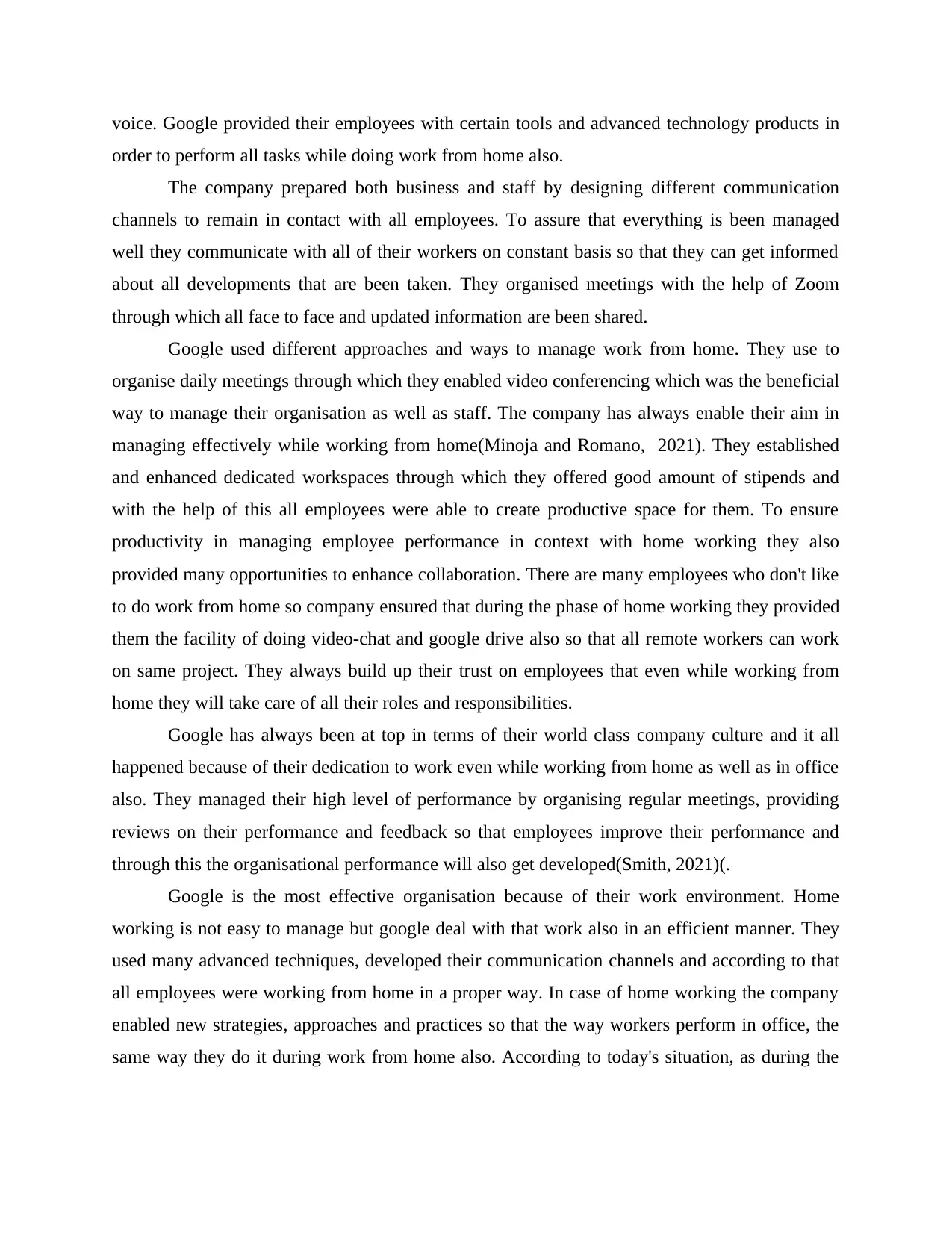
voice. Google provided their employees with certain tools and advanced technology products in
order to perform all tasks while doing work from home also.
The company prepared both business and staff by designing different communication
channels to remain in contact with all employees. To assure that everything is been managed
well they communicate with all of their workers on constant basis so that they can get informed
about all developments that are been taken. They organised meetings with the help of Zoom
through which all face to face and updated information are been shared.
Google used different approaches and ways to manage work from home. They use to
organise daily meetings through which they enabled video conferencing which was the beneficial
way to manage their organisation as well as staff. The company has always enable their aim in
managing effectively while working from home(Minoja and Romano, 2021). They established
and enhanced dedicated workspaces through which they offered good amount of stipends and
with the help of this all employees were able to create productive space for them. To ensure
productivity in managing employee performance in context with home working they also
provided many opportunities to enhance collaboration. There are many employees who don't like
to do work from home so company ensured that during the phase of home working they provided
them the facility of doing video-chat and google drive also so that all remote workers can work
on same project. They always build up their trust on employees that even while working from
home they will take care of all their roles and responsibilities.
Google has always been at top in terms of their world class company culture and it all
happened because of their dedication to work even while working from home as well as in office
also. They managed their high level of performance by organising regular meetings, providing
reviews on their performance and feedback so that employees improve their performance and
through this the organisational performance will also get developed(Smith, 2021)(.
Google is the most effective organisation because of their work environment. Home
working is not easy to manage but google deal with that work also in an efficient manner. They
used many advanced techniques, developed their communication channels and according to that
all employees were working from home in a proper way. In case of home working the company
enabled new strategies, approaches and practices so that the way workers perform in office, the
same way they do it during work from home also. According to today's situation, as during the
order to perform all tasks while doing work from home also.
The company prepared both business and staff by designing different communication
channels to remain in contact with all employees. To assure that everything is been managed
well they communicate with all of their workers on constant basis so that they can get informed
about all developments that are been taken. They organised meetings with the help of Zoom
through which all face to face and updated information are been shared.
Google used different approaches and ways to manage work from home. They use to
organise daily meetings through which they enabled video conferencing which was the beneficial
way to manage their organisation as well as staff. The company has always enable their aim in
managing effectively while working from home(Minoja and Romano, 2021). They established
and enhanced dedicated workspaces through which they offered good amount of stipends and
with the help of this all employees were able to create productive space for them. To ensure
productivity in managing employee performance in context with home working they also
provided many opportunities to enhance collaboration. There are many employees who don't like
to do work from home so company ensured that during the phase of home working they provided
them the facility of doing video-chat and google drive also so that all remote workers can work
on same project. They always build up their trust on employees that even while working from
home they will take care of all their roles and responsibilities.
Google has always been at top in terms of their world class company culture and it all
happened because of their dedication to work even while working from home as well as in office
also. They managed their high level of performance by organising regular meetings, providing
reviews on their performance and feedback so that employees improve their performance and
through this the organisational performance will also get developed(Smith, 2021)(.
Google is the most effective organisation because of their work environment. Home
working is not easy to manage but google deal with that work also in an efficient manner. They
used many advanced techniques, developed their communication channels and according to that
all employees were working from home in a proper way. In case of home working the company
enabled new strategies, approaches and practices so that the way workers perform in office, the
same way they do it during work from home also. According to today's situation, as during the
⊘ This is a preview!⊘
Do you want full access?
Subscribe today to unlock all pages.

Trusted by 1+ million students worldwide
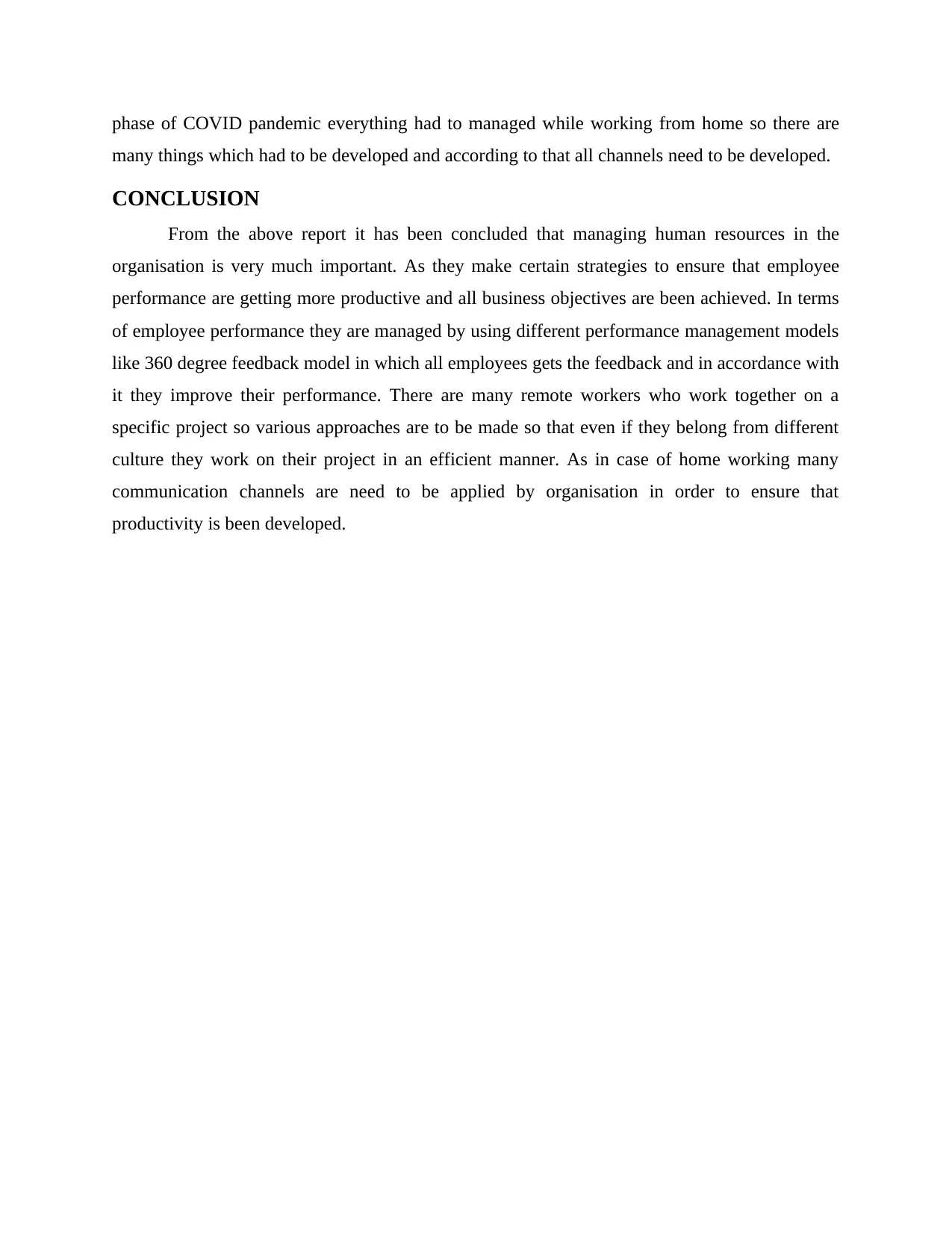
phase of COVID pandemic everything had to managed while working from home so there are
many things which had to be developed and according to that all channels need to be developed.
CONCLUSION
From the above report it has been concluded that managing human resources in the
organisation is very much important. As they make certain strategies to ensure that employee
performance are getting more productive and all business objectives are been achieved. In terms
of employee performance they are managed by using different performance management models
like 360 degree feedback model in which all employees gets the feedback and in accordance with
it they improve their performance. There are many remote workers who work together on a
specific project so various approaches are to be made so that even if they belong from different
culture they work on their project in an efficient manner. As in case of home working many
communication channels are need to be applied by organisation in order to ensure that
productivity is been developed.
many things which had to be developed and according to that all channels need to be developed.
CONCLUSION
From the above report it has been concluded that managing human resources in the
organisation is very much important. As they make certain strategies to ensure that employee
performance are getting more productive and all business objectives are been achieved. In terms
of employee performance they are managed by using different performance management models
like 360 degree feedback model in which all employees gets the feedback and in accordance with
it they improve their performance. There are many remote workers who work together on a
specific project so various approaches are to be made so that even if they belong from different
culture they work on their project in an efficient manner. As in case of home working many
communication channels are need to be applied by organisation in order to ensure that
productivity is been developed.
Paraphrase This Document
Need a fresh take? Get an instant paraphrase of this document with our AI Paraphraser
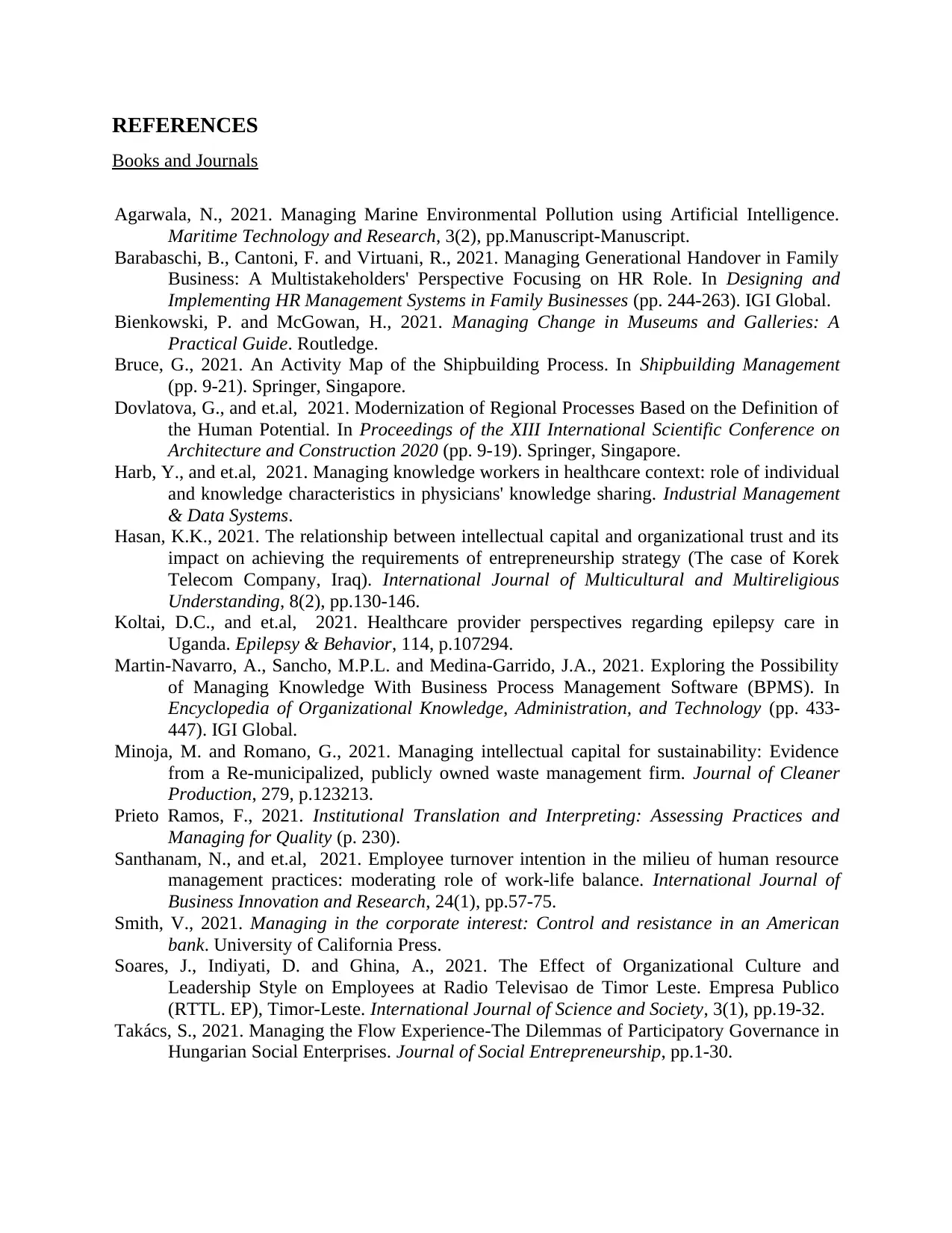
REFERENCES
Books and Journals
Agarwala, N., 2021. Managing Marine Environmental Pollution using Artificial Intelligence.
Maritime Technology and Research, 3(2), pp.Manuscript-Manuscript.
Barabaschi, B., Cantoni, F. and Virtuani, R., 2021. Managing Generational Handover in Family
Business: A Multistakeholders' Perspective Focusing on HR Role. In Designing and
Implementing HR Management Systems in Family Businesses (pp. 244-263). IGI Global.
Bienkowski, P. and McGowan, H., 2021. Managing Change in Museums and Galleries: A
Practical Guide. Routledge.
Bruce, G., 2021. An Activity Map of the Shipbuilding Process. In Shipbuilding Management
(pp. 9-21). Springer, Singapore.
Dovlatova, G., and et.al, 2021. Modernization of Regional Processes Based on the Definition of
the Human Potential. In Proceedings of the XIII International Scientific Conference on
Architecture and Construction 2020 (pp. 9-19). Springer, Singapore.
Harb, Y., and et.al, 2021. Managing knowledge workers in healthcare context: role of individual
and knowledge characteristics in physicians' knowledge sharing. Industrial Management
& Data Systems.
Hasan, K.K., 2021. The relationship between intellectual capital and organizational trust and its
impact on achieving the requirements of entrepreneurship strategy (The case of Korek
Telecom Company, Iraq). International Journal of Multicultural and Multireligious
Understanding, 8(2), pp.130-146.
Koltai, D.C., and et.al, 2021. Healthcare provider perspectives regarding epilepsy care in
Uganda. Epilepsy & Behavior, 114, p.107294.
Martin-Navarro, A., Sancho, M.P.L. and Medina-Garrido, J.A., 2021. Exploring the Possibility
of Managing Knowledge With Business Process Management Software (BPMS). In
Encyclopedia of Organizational Knowledge, Administration, and Technology (pp. 433-
447). IGI Global.
Minoja, M. and Romano, G., 2021. Managing intellectual capital for sustainability: Evidence
from a Re-municipalized, publicly owned waste management firm. Journal of Cleaner
Production, 279, p.123213.
Prieto Ramos, F., 2021. Institutional Translation and Interpreting: Assessing Practices and
Managing for Quality (p. 230).
Santhanam, N., and et.al, 2021. Employee turnover intention in the milieu of human resource
management practices: moderating role of work-life balance. International Journal of
Business Innovation and Research, 24(1), pp.57-75.
Smith, V., 2021. Managing in the corporate interest: Control and resistance in an American
bank. University of California Press.
Soares, J., Indiyati, D. and Ghina, A., 2021. The Effect of Organizational Culture and
Leadership Style on Employees at Radio Televisao de Timor Leste. Empresa Publico
(RTTL. EP), Timor-Leste. International Journal of Science and Society, 3(1), pp.19-32.
Takács, S., 2021. Managing the Flow Experience-The Dilemmas of Participatory Governance in
Hungarian Social Enterprises. Journal of Social Entrepreneurship, pp.1-30.
Books and Journals
Agarwala, N., 2021. Managing Marine Environmental Pollution using Artificial Intelligence.
Maritime Technology and Research, 3(2), pp.Manuscript-Manuscript.
Barabaschi, B., Cantoni, F. and Virtuani, R., 2021. Managing Generational Handover in Family
Business: A Multistakeholders' Perspective Focusing on HR Role. In Designing and
Implementing HR Management Systems in Family Businesses (pp. 244-263). IGI Global.
Bienkowski, P. and McGowan, H., 2021. Managing Change in Museums and Galleries: A
Practical Guide. Routledge.
Bruce, G., 2021. An Activity Map of the Shipbuilding Process. In Shipbuilding Management
(pp. 9-21). Springer, Singapore.
Dovlatova, G., and et.al, 2021. Modernization of Regional Processes Based on the Definition of
the Human Potential. In Proceedings of the XIII International Scientific Conference on
Architecture and Construction 2020 (pp. 9-19). Springer, Singapore.
Harb, Y., and et.al, 2021. Managing knowledge workers in healthcare context: role of individual
and knowledge characteristics in physicians' knowledge sharing. Industrial Management
& Data Systems.
Hasan, K.K., 2021. The relationship between intellectual capital and organizational trust and its
impact on achieving the requirements of entrepreneurship strategy (The case of Korek
Telecom Company, Iraq). International Journal of Multicultural and Multireligious
Understanding, 8(2), pp.130-146.
Koltai, D.C., and et.al, 2021. Healthcare provider perspectives regarding epilepsy care in
Uganda. Epilepsy & Behavior, 114, p.107294.
Martin-Navarro, A., Sancho, M.P.L. and Medina-Garrido, J.A., 2021. Exploring the Possibility
of Managing Knowledge With Business Process Management Software (BPMS). In
Encyclopedia of Organizational Knowledge, Administration, and Technology (pp. 433-
447). IGI Global.
Minoja, M. and Romano, G., 2021. Managing intellectual capital for sustainability: Evidence
from a Re-municipalized, publicly owned waste management firm. Journal of Cleaner
Production, 279, p.123213.
Prieto Ramos, F., 2021. Institutional Translation and Interpreting: Assessing Practices and
Managing for Quality (p. 230).
Santhanam, N., and et.al, 2021. Employee turnover intention in the milieu of human resource
management practices: moderating role of work-life balance. International Journal of
Business Innovation and Research, 24(1), pp.57-75.
Smith, V., 2021. Managing in the corporate interest: Control and resistance in an American
bank. University of California Press.
Soares, J., Indiyati, D. and Ghina, A., 2021. The Effect of Organizational Culture and
Leadership Style on Employees at Radio Televisao de Timor Leste. Empresa Publico
(RTTL. EP), Timor-Leste. International Journal of Science and Society, 3(1), pp.19-32.
Takács, S., 2021. Managing the Flow Experience-The Dilemmas of Participatory Governance in
Hungarian Social Enterprises. Journal of Social Entrepreneurship, pp.1-30.

⊘ This is a preview!⊘
Do you want full access?
Subscribe today to unlock all pages.

Trusted by 1+ million students worldwide
1 out of 20
Related Documents
Your All-in-One AI-Powered Toolkit for Academic Success.
+13062052269
info@desklib.com
Available 24*7 on WhatsApp / Email
![[object Object]](/_next/static/media/star-bottom.7253800d.svg)
Unlock your academic potential
Copyright © 2020–2025 A2Z Services. All Rights Reserved. Developed and managed by ZUCOL.




